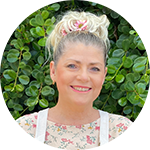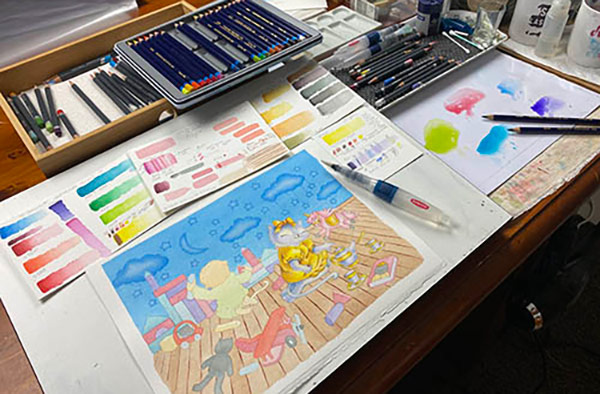and share it with your friends!
We often hear people say (about an artist) when they admire a great realism drawing, “Oh he’s definitely got the Artist’s Eye” but what is The Artist’s Eye and how can you can get it?
It’s true, you do need to have ‘The Artist’s Eye’ to be able to draw a realistic likeness, but did you know that most average healthy people are naturally born with the skills needed to develop The Artist’s Eye? This is great news for you because you can learn to draw really well too!
You can develop the artist’s eye and improve your drawing skills immediately if you have the dexterity to hold a pencil and write your name, can cut a chocolate cake in half, straighten a painting on a wall, place objects in a room to fill it comfortably, and if you can sense whether it is morning or afternoon on a blue sky day just by the tone in the sky.
The main thing standing between you and your ability to learn how to draw right now is the way you are currently looking at things.
Today I am sharing a huge drawing secret with you; the secret of how you too can develop the artist’s eye and draw like you never before thought was possible.
Looking with your whole mind
Developing The Artist’s Eye is not simply about seeing things more clearly, looking harder or staring for longer, its about learning to see things differently than the way most people see things. When we’re using our Artist’s Eye, we are looking with our whole mind involved in the process and as a result our entire lives are enriched.
This is very different to the way we normally see things. As adults, we usually look at things with a fleeting glance as we rush about our daily activities. We rarely take the time to count the number of petals on a flower let alone notice the incredible and perfect rules of division that nature uses to create with.
Sure, some people have discovered that we can stare at the thing we want to draw and wait for a special Zen-like, euphoric state to arrive and transport us away to some magical place. Sometimes it happens when you wait long enough and look hard enough but sadly other times it just doesn’t. This state of mind has been known as; ‘the zone’ or ‘tapping into the right, creative side of the brain’ and it requires us to be very patient and persistent.
However, this staring and waiting approach isn’t very reliable or as helpful as it could be; especially when we only have precious little blocks of time to work within (I call this our Pyjama Time™ because quite often we find spare time when we are in our pyjamas.) There will always be a need for that important illumination time, when our ideas are just evolving, however, I am talking about once the idea has already been decided upon and we have moved onto the tangible creation of our artwork. We need to have a reliable process to help us get started and carry through the creation of the actual artwork at a time that suits us and our lifestyle. This is where the development of The Artist’s Eye is crucial in helping us avoid procrastination and make the most use of our valuable Pyjama Time.
Instead of hoping for this Zen-like state to eventually arrive (by staring and waiting, and often getting depressed in the process) you can use the ‘Artist’s Language’ to immediately access your Artist’s Eye and the natural skills you need for drawing realistically. Your drawings will improve immediately once you begin to access your Artist’s Eye.
Step One: Become aware of the messages in your brain while you are drawing
Becoming aware of what your brain is saying to you while you draw is the first step towards accessing and then developing your Artist’s Eye. The exciting thing about developing the Artist’s Eye is that it has little do to with the eyeball itself; it’s all about becoming aware of, and gaining control over the messages that are going on within our brain as we attempt to draw or paint.
The Artist’s Eye is a simple label given to a fascinating mental process; it’s actually a unique kind of dialogue that goes on in our brain while we draw. We look with our mind, not our eye, our eye is just the window that opens and shuts to let in the information that is in front of us. From the time we look at something, to the time that vision goes into our brain and then out to our hand, unless we use this unique kind of dialogue (which I call the Artist’s Language) the image we draw is often something completely different than what we intended. Many people give up learning to draw believing they just aren’t talented and really talent has nothing to do with it. It is the ability to access the Artist’s Eye through using the Artist’s Language that really enables people to draw.
Once you are aware of what your brain is saying to you, then you can take steps to change the messages to become beneficial rather than constantly trying to sabotage your attempts to draw in the first place. This is the initial step in developing your Artists Eye; to bring the subconscious (often negative) self-talk into the conscious through using the Artist’s Language.
Step Two: Take control and use the Artist’s Language while you draw
In the very first unit of ‘The Complete Draw and Paint In Your Pyjamas Certificate Course’ you are introduced to the Artist’s Language which enables you to enter that special state often known as ‘The Artist’s Eye’ immediately and on-demand. No it’s not technical artist’s jargon it is simple everyday thoughts that require you to ask yourself some basic questions about the object you are drawing.
Let me explain a little more. Has anyone ever tried to help you learn to draw and simply said to you, “Look! Just look harder! Stare at it and you will eventually be able to draw it!” I can clearly remember the frustration of not being able to see what I was supposed to see and gave up drawing at the age of fourteen years believing I just was not talented enough. I didn’t begin to draw until the age of 23 years when I turned to art as a form of ‘therapy’ to help me recover from a chronic debilitating illness. The illness changed my life forever, it affected all of my cognitive abilities and left me unable to walk more than a couple of metres at a time. Art became my life saver and I painted my way through the pain. I also discovered that I really could draw after all.
What I should have been told at that tender age of just 14 years, instead of, “Look! Just look harder,” is “Look and compare!”
The things we must give our brain to think about are questions and statements which involve four major comparison skills (that most people are born with.) Here are the four major comparison skills, these are the things we should be told to do when looking at an object in order to draw it;
- Look and compare the angles, lines and curves to a vertical or horizontal line.
- Look and compare the tones to a value scale and to one another.
- Look and compare the size of a part to the whole.
- Look and compare the object to other objects surrounding it and to the shape of our picture surface.
Once the logic reasoning part of our brain has to assess these four major comparison skills through asking questions and making statements about these comparisons, it becomes pre-occupied and no longer tells us things to prevent us from drawing. Through this process of asking questions about the object, you will find yourself able to draw better immediately because you are using your Artist’s Eye.
In summary; we can change the messages in our mind and access our Artist’s Eye to draw better immediately by simply using the Artist’s Language. If we give our logic brain a job to do we trick it into cooperating and working synergistically with us to actually help us draw, almost like magic!
Here at Drawpj.com we will be there to help you every step of the way, you will always be supported in a caring and encouraging online community and together we will help you rise above and develop your artist’s eye











